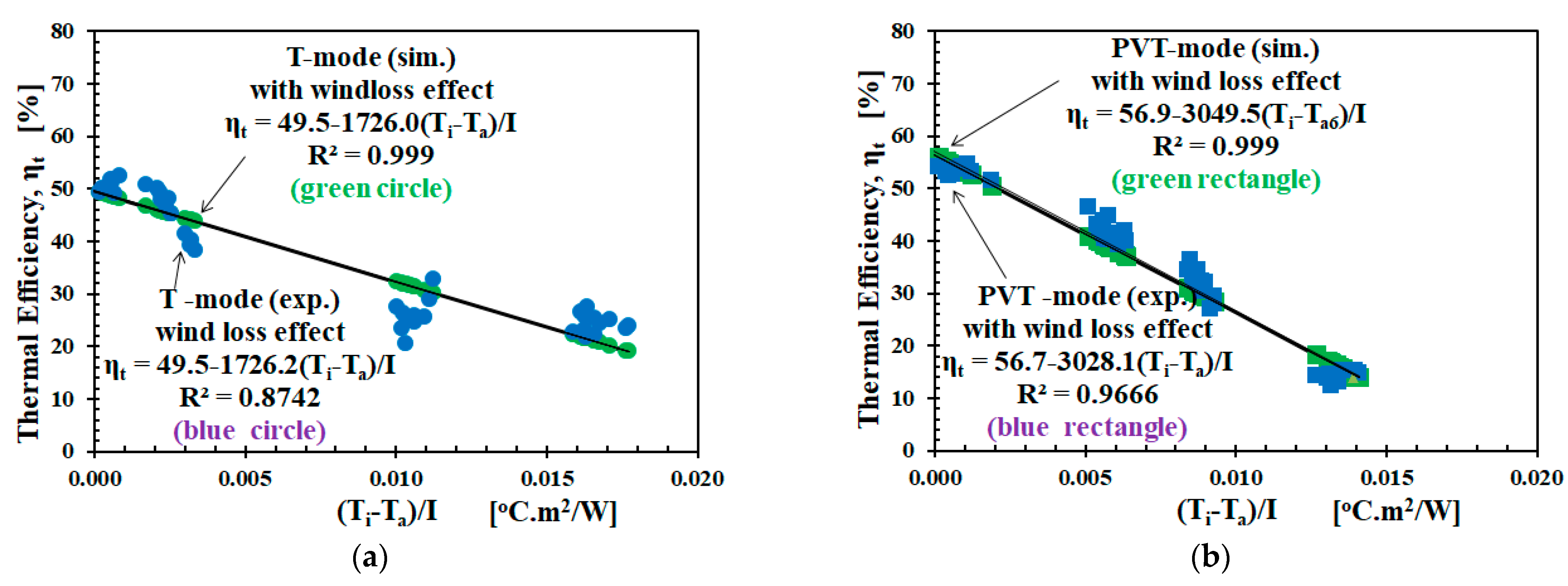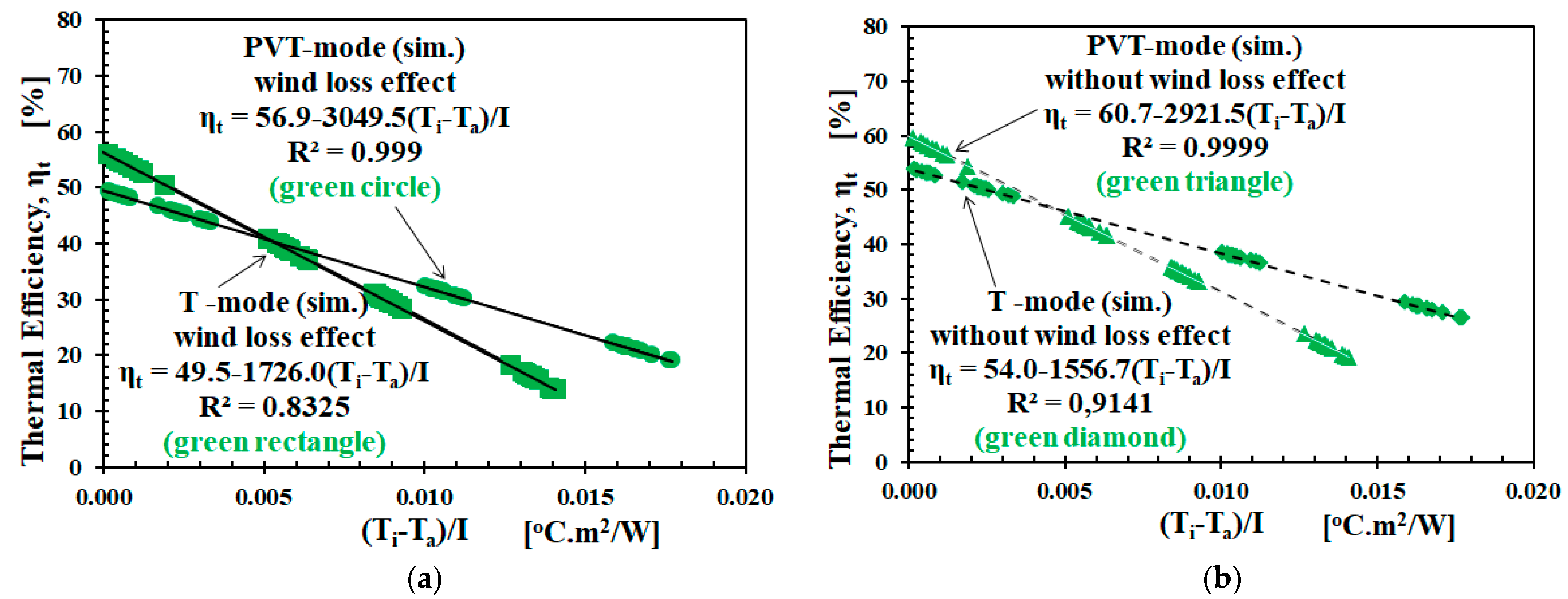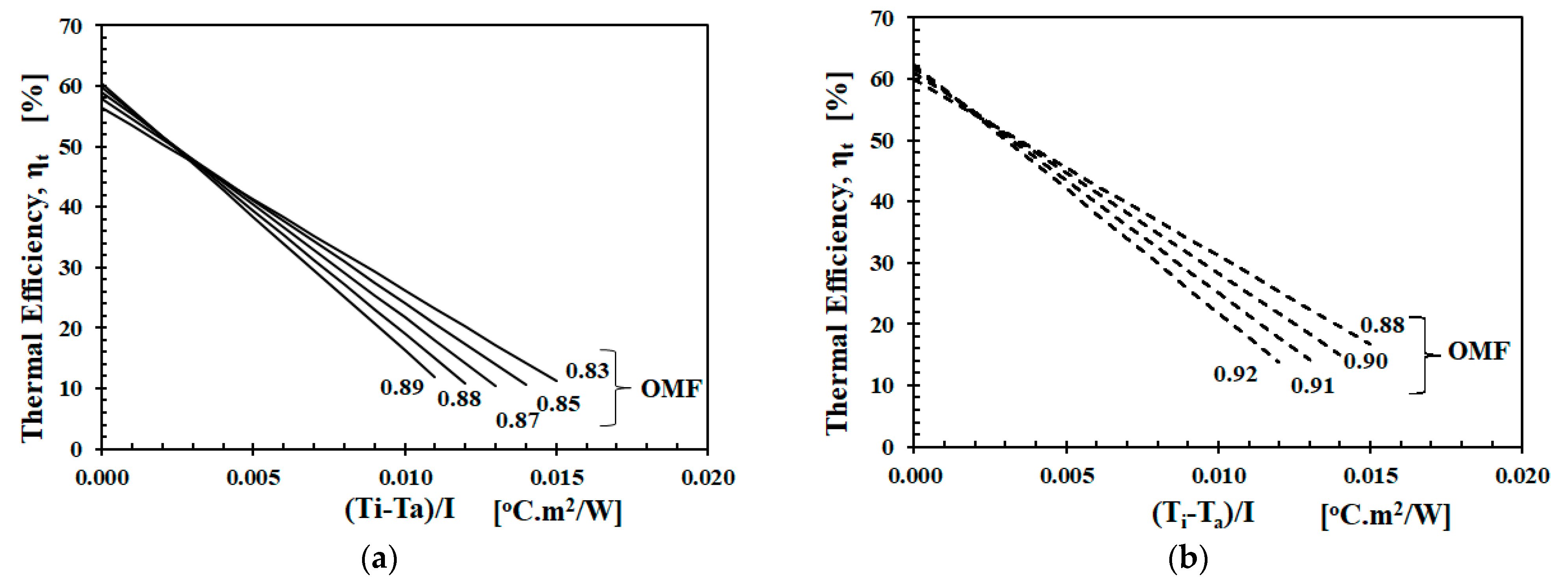Modeling Joule Heating Effect on Thermal Efficiency of Photovoltaic Thermal (PVT) Collectors with Operation Mode Factor (OMF)
Abstract
:1. Introduction
2. Materials and Methods
2.1. Experiment Setup
2.2. Construction of Operation Mode Factor (OMF)
2.3. Validation
3. Result and Discussion
3.1. Reconstruction Thermal Efficiency with Operation Mode Factor (OMF)
3.2. Simulation
4. Discussion
5. Conclusions
Funding
Data Availability Statement
Acknowledgments
Conflicts of Interest
Abbreviations
| PVT | Hybrid photovoltaic and thermal |
| EVA | Ethylene Vinyl Acetate |
| SC | Short-circuit |
| RMS | Root mean square |
| OMF | Operation mode factor |
| p-Si | Polycrystalline silicon |
| MPPT | Maximum power point tracking |
| OC | Open-circuit |
| vs. | Versus |
| Nomenclatures | |
| Collector surface temperature [°C] | |
| Absorber temperature [°C] | |
| Inlet water temperature [°C] | |
| Medium temperature of fluid [°C] | |
| Ambient air temperature [°C] | |
| Collector overall loss coefficient [W/m2.°C] | |
| Electrical efficiency of PV [%] | |
| Temperature coefficient of PV cell | |
| Thermal efficiency of a collector [%] | |
| Total efficiency of PVT collector [%] | |
| Thermal efficiency from simulation [%] | |
| Thermal efficiency from regression [%] | |
| Number of data points observed | |
| RMS value regression to experiment | |
| Total solar energy strikes the system [W] | |
| Thermal energy converted [W] | |
| Energy loss by reflection [W] | |
| Energy loss by convection [W] | |
| Total losses [W] | |
| Energy generated by the PV cell [W] | |
| Cond. h. tr. coeff. Surf. – Abs. [W/m2.°C] | |
| Energy loss by reflection [W] | |
| Energy loss by convection [W] | |
| Useful heat collected by the fluid [W] | |
| Mass flow rate [m3/s] or [litre/minute] | |
| Effective PV area [m2] | |
| Voltage output of PV at MPPT [V] | |
| Current output of PV at MPPT [A] | |
| Load resistor [Ω] | |
| Outlet water temperature [°C] | |
| Total area of PVT collector [m2] | |
| Heat removal factor | |
| Reference efficiency of PV cell [%] | |
| Reference temperature of PV cell [%] | |
| Transmittance | |
| Absorptance | |
| Optical efficiency [%] | |
| Thermal efficiency from the experiment | |
| RMS value simulation to experiment | |
| RMS value simulation to regression | |
| Thermal energy transferred to the fluid [W] | |
| Energy loss radiation [W] | |
| Solar energy converted by PVT [W] | |
| Electrical energy converted by PV [W] | |
| Electro-thermal / internal heating energy [W] | |
| Useful heat from internal heating [W] | |
| Waste heat from internal heating [W] | |
| Overall loss coefficient [W/m2.°C] | |
| Operation Mode Factor for PVT-mode | |
| Operation Mode Factor for T-mode |
References
- Chandrasekar, T.S.M. Five decades of evolution of solar photovoltaic thermal (PVT) technology—A critical insight on review articles. Clean. Prod. 2021, 322. [Google Scholar] [CrossRef]
- Mellit, A.; Pavan, A.M.; Ogliari, E.; Leva, S.; Lughi, V. Advanced methods for photovoltaic output power forecasting: A review. Appl. Sci. 2020, 10, 487. [Google Scholar] [CrossRef] [Green Version]
- Sultan, S.M.; Ervina Efzan, M.N. Review on recent Photovoltaic/Thermal (PV/T) technology advances and applications. Sol. Energy 2018, 173, 939–954. [Google Scholar] [CrossRef]
- Evans, D.L. Simplified method for predicting photovoltaic array output. Sol. Energy 1981, 27, 555–560. [Google Scholar] [CrossRef]
- Herrando, M.; Simón, R.; Guedea, I.; Fueyo, N. The challenges of solar hybrid PVT systems in the food processing industry. Appl. Therm. Eng. 2021, 184, 116235. [Google Scholar] [CrossRef]
- Das, D.; Kalita, P.; Roy, O. Flat plate hybrid photovoltaic- thermal (PV/T) system: A review on design and development. Renew. Sustain. Energy Rev. 2018, 84, 111–130. [Google Scholar] [CrossRef]
- Florschuetz, L.W. Extension of the Hottel-Whillier model to the analysis of combined photovoltaic/thermal flat plate collectors. Sol. Energy 1979, 22, 361–366. [Google Scholar] [CrossRef]
- Hottel, H.C.; Willier, A. Evaluation of Flat-Plate Solar Collector Performance Transactions of the Conference on the Use of Solar Energy; University of Arizona Press: Tucson, AZ, USA, 1958; Volume 3, pp. 74–104. [Google Scholar]
- Guarracino, I.; Freeman, J.; Ramos, A.; Kalogirou, S.A.; Ekins-daukes, N.J.; Markides, C.N. Systematic testing of hybrid PV-Thermal (PVT) solar collectors in steady-state and dynamic outdoor conditions. Appl. Energy 2019, 240, 1014–1030. [Google Scholar] [CrossRef]
- Akhsassi, M.; El Fathi, A.; Erraissi, N.; Aarich, N.; Bennouna, A.; Raou, M.; Outzourhit, A. Experimental investigation and modeling of the thermal behavior of a solar PV module. Sol. Energy Mater. Sol. Cells 2018, 180, 271–279. [Google Scholar] [CrossRef]
- Sandnes, B.; Rekstad, J. A photovoltaic/thermal (PV/T) collector with a polymer absorber plate. Experimental study and analytical model. Sol. Energy 2002, 72, 63–73. [Google Scholar] [CrossRef]
- Pokorny, N.; Matuska, T. Borivoj Sourek Modeling of glazed Liquid PV-T collector with use of detail model. In Proceedings of the 14th Conference of International Building Performance Simulation Association, Hyderabad, India, 7-9 December 2015; IBPSA. pp. 2554–2560. [Google Scholar]
- Yandri, E. The Effect of Joule Heating to Thermal Performance of hybrid PVT Collector during Electricity Generation. Renew. Energy 2017, 111, 344–352. [Google Scholar] [CrossRef]
- Salameh, T.; Tawalbeh, M.; Juaidi, A.; Abdallah, R. A novel three-dimensional numerical model for PV/T water system in hot climate region Tareq. Renew. Energy 2020, 164, 1320–1333. [Google Scholar] [CrossRef]
- Boumaaraf, B.; Touafek, K.; Ait-cheikh, M.S.; Slimani, M.E.A. Comparison of electrical and thermal performance evaluation of a classical PV generator and a water glazed hybrid photovoltaic–thermal collector. Math. Comput. Simul. 2020, 167, 176–193. [Google Scholar] [CrossRef]
- Boumaaraf, B.; Boumaaraf, H.; Slimani, M.E.A.; Tchoketch_Kebir, S.; Ait-cheikh, M.S.; Touafek, K. Performance evaluation of a locally modified PV module to a PV/T solar collector under climatic conditions of semi-arid region. Math. Comput. Simul. 2020, 167, 135–154. [Google Scholar] [CrossRef]
- Sahlaoui, K.; Oueslati, H.; Mabrouk, S. Ben Thermal and electrical performance evaluation of hybrid air PV/T collector–numerical analysis and experimental study. Int. J. Sustain. Energy 2021. [Google Scholar] [CrossRef]
- Slimani, M.E.A.; Amirat, M.; Kurucz, I.; Bahria, S.; Hamidat, A.; Chaouch, W.B. A detailed thermal-electrical model of three photovoltaic/thermal (PV/T) hybrid air collectors and photovoltaic (PV) module: Comparative study under Algiers climatic conditions. Energy Convers. Manag. 2017, 133, 458–476. [Google Scholar] [CrossRef]
- Simonetti, R.; Molinaroli, L.; Manzolini, G. Development and validation of a comprehensive dynamic mathematical model for hybrid PV/T solar collectors. Appl. Therm. Eng. 2018, 133, 543–554. [Google Scholar] [CrossRef]
- Yu, Q.; Hu, M.; Li, J.; Wang, Y.; Pei, G. Development of a 2D temperature-irradiance coupling model for performance characterizations of the flat-plate photovoltaic/thermal (PV/T) collector. Renew. Energy 2020, 153, 404–419. [Google Scholar] [CrossRef]
- M’Sirdi, N.K.; Benabdellatif, M.; Tina, G.M.; Naamane, A. Dynamic coupled electrical and thermal model for PV-T solar energy collectors. In Proceedings of the 2018 5th International Symposium on Environment-Friendly Energies and Applications (EFEA), Rome, Italy, 24–26 September 2018; pp. 1–8. [Google Scholar] [CrossRef]
- El Manssouri, O.; Hajji, B.; Tina, G.M.; Gagliano, A.; Aneli, S. Electrical and thermal performances of Bi-fluid PV/thermal collectors. Energies 2021, 14, 1633. [Google Scholar] [CrossRef]
- Baljit, S.S.S.; Chan, H.Y.; Audwinto, V.A.; Hamid, S.A.; Fudholi, A.; Zaidi, S.H.; Othman, M.Y.; Sopian, K. Mathematical modelling of a dual-fluid concentrating photovoltaic-thermal (PV-T) solar collector. Renew. Energy 2017, 114, 1258–1271. [Google Scholar] [CrossRef]
- Shen, C.; Liu, F.; Qiu, S.; Liu, X.; Yao, F.; Zhang, Y. Numerical study on the thermal performance of photovoltaic thermal (PV/T) collector with different parallel cooling channels. Sustain. Energy Technol. Assessments 2021, 45, 101101. [Google Scholar] [CrossRef]
- Najafi, H.; Woodbury, K.A. Optimization of a cooling system based on Peltier effect for photovoltaic cells. Sol. Energy 2013, 91, 152–160. [Google Scholar] [CrossRef]
- Das, D.; Kalita, P.; Dewan, A.; Tanweer, S. Development of a novel thermal model for a PV/T collector and its experimental analysis. Sol. Energy 2019, 188, 631–643. [Google Scholar] [CrossRef]
- Wu, J.; Zhan, X.; Shen, J.; Wu, Y.; Connelly, K.; Yang, T.; Tang, L.; Xiao, M.; Wei, Y.; Jiang, K.; et al. A review of thermal absorbers and their integration methods for the combined solar photovoltaic/thermal (PV/T) modules. Renew. Sustain. Energy Rev. 2017, 75, 839–854. [Google Scholar] [CrossRef]
- Bahaidarah, H.; Subhan, A.; Gandhisan, P.; Rehman, S. Performance evaluation of a PV (photovoltaic ) module by back surface water cooling for hot climatic conditions. Energy 2016, 59, 445–453. [Google Scholar] [CrossRef]
- Yandri, E. Uniformity characteristic and calibration of simple low cost compact halogen solar simulator for indoor experiments. Int. J. Low-Carbon Technol. 2018, 13, 1–13. [Google Scholar] [CrossRef]
- Sajjad, U.; Amer, M.; Ali, H.M.; Dahiya, A.; Abbas, N. Cost effective cooling of photovoltaic modules to improve efficiency. Case Stud. Therm. Eng. 2019, 14, 100420. [Google Scholar] [CrossRef]
- Chen, J.F.; Zhang, L.; Dai, Y.J.; Zhang, L.; Dai, Y.J. Performance analysis and multi-objective optimization of a hybrid photovoltaic/thermal collector for domestic hot water application. Energy 2017, 143, 500–516. [Google Scholar] [CrossRef]
- Orlando Montoya-Marquez, J.J.F.-P. Heat Removal Factor in Flat Plate Solar Collectors: Indoor Test Method. Energies 2018, 11, 2783. [Google Scholar] [CrossRef] [Green Version]
- Duffie, J.A.; Beckman, W.A. Solar Energy of Thermal Processes Solar Engineering, 4th ed.; John Wiley & Sons: Madison, WI, USA, 2013; ISBN 9780470873663. [Google Scholar]
- Rosli, M.A.M.; Sopian, K.; Mat, S.B.; Sulaiman, M.Y.; Salleh, E. Heat Removal Factor of an Unglazed Photovoltaic Thermal Collector with a Serpentine Tube. In Renewable Energy in the Service of Mankind Vol II; Springer: Cham, Switzerland, 2016; Volume II, pp. 583–590. ISBN 9783319182155. [Google Scholar] [CrossRef]
- Hussein, A. Kazem Evaluation and analysis of water-based photovoltaic_thermal (PV/T) system. Case Stud. Therm. Eng. 2019, 13, 100401. [Google Scholar] [CrossRef]
- Bergene, T.; Lovvik, O.M. Model calculations on a flat-plate solar heat collector with integrated solar cells. Fuel Energy Abstr. 1996, 37, 200. [Google Scholar] [CrossRef]
- Zohri, M.; Fudholi, A.; Ruslan, M.H.; Sopian, K. Mathematical modeling of photovoltaic thermal PV/T system with v-groove collector. AIP Conf. Proc. 2016, 1862, 030063. [Google Scholar] [CrossRef] [Green Version]
- Khelifa, A.; Touafek, K.; Moussa, H.B.; Tabet, I. Modeling and detailed study of hybrid photovoltaic thermal (PV/T) solar collector. Sol. Energy 2016, 135, 169–176. [Google Scholar] [CrossRef]
- Lämmle, M.; Kroyer, T.; Fortuin, S.; Wiese, M.; Hermann, M. Development and modelling of highly-efficient PVT collectors with low-emissivity coatings. Sol. Energy 2016, 130, 161–173. [Google Scholar] [CrossRef]
- Yandri, E. Development and experiment on the performance of polymeric hybrid Photovoltaic Thermal (PVT) collector with halogen solar simulator. Sol. Energy Mater. Sol. Cells 2019, 201, 110066. [Google Scholar] [CrossRef]
- Yandri, E. Dataset of the PV Surface Temperature Distribution When Generating Electricity (PV-On) and Without Generating Electricity (PV-Off) Using Halogen Solar Simulator. Data Br. 2019, 27, 104578. [Google Scholar] [CrossRef]
- Souliotis, M.; Arnaoutakis, N.; Panaras, G.; Kavga, A.; Papaefthimiou, S. Experimental study and Life Cycle Assessment (LCA) of Hybrid Photovoltaic/Thermal (PV/T) solar systems for domestic applications. Renew. Energy 2018, 126, 708–723. [Google Scholar] [CrossRef]
- Hussain, M.I.; Kim, J.T. Outdoor testing to compare the technical and economic aspects of single-and dual-fluid photovoltaic/thermal (PV/T) systems. Appl. Sci. 2020, 10, 5641. [Google Scholar] [CrossRef]
- Chen, X.; Wang, W.; Luo, D.; Zhu, C. Performance evaluation and optimization of a building-integrated photovoltaic/thermal solar water heating system for exterior shading: A case study in South China. Appl. Sci. 2019, 9, 5395. [Google Scholar] [CrossRef] [Green Version]
- Pakere, I.; Lauka, D.; Blumberga, D. Solar power and heat production via photovoltaic thermal panels for district heating and industrial plant. Energy 2018, 154, 424–432. [Google Scholar] [CrossRef]
- Al-Waeli, A.H.A.; Sopian, K.; Kazem, A.H.; Chaichan, M.T. Novel criteria for assessing PVT solar energy production. Case Stud. Therm. Eng. 2019, 16, 100547. [Google Scholar] [CrossRef]
- Herrando, M.; Ramos, A.; Freeman, J.; Zabalza, I.; Markides, C.N. Technoeconomic modelling and optimisation of solar combined heat and power systems based on fl at-box PVT collectors for domestic applications. Energy Convers. Manag. 2018, 175, 67–85. [Google Scholar] [CrossRef]
- Kuo, C.J.; Liu, J.; Lazuardi, M.; Lan, W. The photovoltaic-thermal system parameter optimization design and practical verification. Energy Convers. Manag. 2019, 180, 358–371. [Google Scholar] [CrossRef]
- Chamkha, A.J.; Selimefendigil, F. Numerical analysis for thermal performance of a photovoltaic thermal solar collector with SiO2-water nanofluid. Appl. Sci. 2018, 8, 2223. [Google Scholar] [CrossRef] [Green Version]
- Chandra, J.; Chyuan, H.; Tong, W.; Izadyar, N. The intelligent forecasting of the performances in PV/T collectors based on soft computing method. Renew. Sustain. Energy Rev. 2017, 72, 1366–13783. [Google Scholar] [CrossRef]







| Items | Wind Loss Effect | Without Wind Loss Effect | |||
|---|---|---|---|---|---|
| Parameter | Unit | T-Mode | PVT-Mode | T-Mode | PVT-Mode |
| W/m2.°C | 44.38 | 176.11 | 46.68 | 242.95 | |
| W/m2.°C | 28.24 | 36.57 | 23.34 | 32.93 | |
| ×100% | 0.495 | 0.567 | 0.540 | 0.603 | |
| °C.m2/W | 0.029 | 0.019 | 0.035 | 0.021 | |
| %.m2/°C.W | 17.26 | 30.28 | 15.58 | 29.00 | |
| % | 16.3 | 11.3 | 14.0 | 10.2 | |
| - | 0.61 | 0.83 | 0.67 | 0.88 | |
| - | 1.36 | 1.31 | |||
| - | 3.84 | 9.82 | |||
| - | 1.27 | 1.43 | |||
| Items | Wind Loss Effect | Without Wind Loss Effect | |||
|---|---|---|---|---|---|
| Parameter | Unit | T-Mode | PVT-Mode | T-Mode | PVT-Mode |
| W/m2.°C | 44.39 | 180.42 | 46.68 | 257.34 | |
| W/m2.°C | 28.25 | 36.70 | 23.34 | 32.96 | |
| ×100% | 0.495 | 0.569 | 0.540 | 0.603 | |
| °C.m2/W | 0.029 | 0.019 | 0.035 | 0.021 | |
| %.m2/°C.W | 17.26 | 30.28 | 15.58 | 29.22 | |
| % | 16.3 | 10.9 | 14.0 | 10.2 | |
| % | 0.00 | 0.82 | 0.02 | 0.74 | |
| - | 1.57 | 4.92 | 2.00 | 7.81 | |
| - | 0.61 | 0.83 | 0.67 | 0.89 | |
| - | 1.36 | 1.33 | |||
| - | 4.06 | 5.51 | |||
| - | 1.30 | 1.41 | |||
Publisher’s Note: MDPI stays neutral with regard to jurisdictional claims in published maps and institutional affiliations. |
© 2022 by the author. Licensee MDPI, Basel, Switzerland. This article is an open access article distributed under the terms and conditions of the Creative Commons Attribution (CC BY) license (https://creativecommons.org/licenses/by/4.0/).
Share and Cite
Yandri, E. Modeling Joule Heating Effect on Thermal Efficiency of Photovoltaic Thermal (PVT) Collectors with Operation Mode Factor (OMF). Appl. Sci. 2022, 12, 742. https://doi.org/10.3390/app12020742
Yandri E. Modeling Joule Heating Effect on Thermal Efficiency of Photovoltaic Thermal (PVT) Collectors with Operation Mode Factor (OMF). Applied Sciences. 2022; 12(2):742. https://doi.org/10.3390/app12020742
Chicago/Turabian StyleYandri, Erkata. 2022. "Modeling Joule Heating Effect on Thermal Efficiency of Photovoltaic Thermal (PVT) Collectors with Operation Mode Factor (OMF)" Applied Sciences 12, no. 2: 742. https://doi.org/10.3390/app12020742






